American Civil War Tokens
American Civil War Tokens
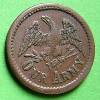
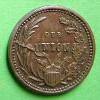
Tokens were produced widely during the American Civil War to remedy a dearth of official coin brought about at an early stage by its economic consequences. They were issued only for about 21 months, Q3/1862 to Q2/1864, but a total mintage well in excess of 25 million pieces is estimated, from about 400 towns and 1500 individual merchants. 22 states are represented, but a contiguous group of seven are prominent: Ohio, New York, Michigan, Indiana, Wisconsin, Pennsylvania and Illinois. Nearly all Civil War Tokens (CWTs) derive from the Unionist side, the Confederates being afflicted with a severe dearth of copper. Some thirty or so manufacturers have been identified, mostly operating from the larger cities of the above states, who commonly charged their clients 73 cents per hundred pieces.
The US small cent of 19-20mm diameter had been introduced in 1856 and the majority of pieces coincide very closely with this; there are also a few larger pieces, in the 24-27mm range. In terms of design, the cent-like pieces fall into two categories: Patriotics, which are of a general nature and frequently express political sentiments, and Store Cards, which bear the names and designs of individual merchants. The choice between a standard {Patriotic} and specific {Storecard} design was usually an issue of cost, the personalized version being more expensive, and many different combinations of obverse and reverse are found. There are few obvious town pieces, so it is presumed that civic issues were usually of the double-patriotic type.
The majority of CWTs are made of copper or brass, although rarely some other material is used, such as compressed india-rubber; some of them actually state that they are cents, although the majority do not. Beyond the Patriotics and Storecards, however, there is also another series of pieces called Sutler tokens, struck by the travelling tradesmen who serviced the frontier forts; these are often of different value, size or metallic structure, rarely as attractive as the other CWTs, and always very scarce. The values are usually stated and may be anything up to $1, although the most common were 10c, 15c and 25c.
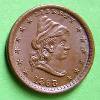
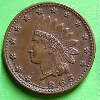
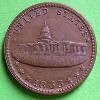
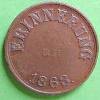
Patriotics depict a relatively small number of common themes: the generic Liberty and Indian heads, variously rendered by the different manufacturers; the various political and military personalities of the period; other symbols of the Union, festooned with patriotic sentiment; the equipment of warfare; statements of patriotic belief. Occasional pieces bear witness to the presence of significant immigrant populations, e.g. the patriotic “Erinnerung am 1863”; German surnames are particularly in evidence on storecards, whilst the solitary piece which depicts Hebrew wording is always popular.
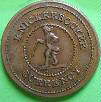
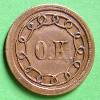
Amongst the more interesting references on Patriotics are the fictitious Diedrich Knickerbocker, now better known in connection with ice cream; and Martin van Buren, alias Ole Kinderhook, whose initials “OK” have now passed into common parlance as indicating a situation of stability. The implication of the original token, which depicts Lincoln on the other side, was that Van Buren was a safe pair of hands.
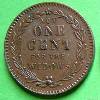
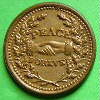
As with the other British and American series of previous decades there is always evidence of satire and political cynicism, and there is also a small minority group of pieces advertising pacifism.
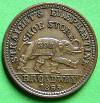
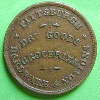
Most Storecards commence with a basic textual statement of the issuer’s name, address and type of business. The second side, where specific rather than patriotic, tends to depict the specifics of that trade, which is frequently concerned with the basic needs of frontier life: hardware, refreshment, clothing, medicine and the like. The range of goods advertised is somewhat different from that advertised on the contemporary unofficial farthings of the UK, where one would be less likely to find stoves, grindstones, saws, garden rollers, safes, and fishing tackle. Finally, spare a thought for the poor pig depicted on the obverse of butcher Thomas White’s piece, who might be feeling a little uncomfortable if he could read the reverse advertising his master’s premises at 13-14 Abattoir Place!
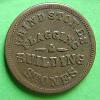
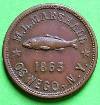
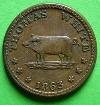
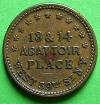
Certain very specific advertisements include some for the Union Recruitment Fairs, or by war agents making a living out of the financial logistics of frontier conflict. One piece was issued by the company which ran the New York to Albany Ferry, and descends to the precise details of the timetable.
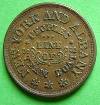
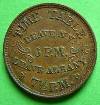
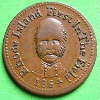
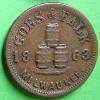
There are over thirty known die-sinkers, some of whom have distinctive styles; for example the Rhode Island die-sinker, name unknown, who uses lower case lettering, and Marr of Milwaukee, who enjoyed a near-monopoly of Wisconsin’s issues.
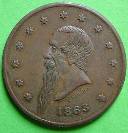
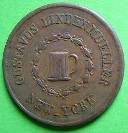
The largest single individual issue was the million or so pieces issued by the distinctive long-bearded Gustavus Lindenmueller of New York, whose reputed mocking refusal to redeem a large number of tokens held by a major railroad company was one of several similar incidents which prompted Congress to put an end to the series in 1864.
Useful References and Links:
George & Melvin Fuld: Civil War Store Cards.
George & Melvin Fuld: Patriotic Civil War Tokens.
David E. Schenkman: Civil War Sutler Tokens and Cardboard Scrip.
Byron Kanzinger: Civil War Token Price Guide.
An active Civil War Token Society exists; details at http://www.cwtsociety.com
David Powell
October 2006
